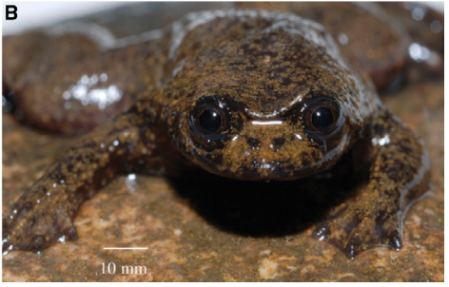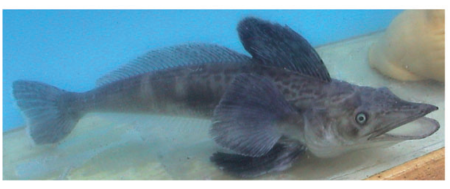![]() Today I stumbled upon two blog posts that really capture some of the beauty of the diverse adaptations in nature.
Today I stumbled upon two blog posts that really capture some of the beauty of the diverse adaptations in nature.
Random Biology writes about creatures living in cold waters. Water can carry oxygen at a far greater density at lower temperatures. This simple phenomenon, combined with the slower metabolism of cold tissues, has made it possible for certain salamanders to get along fine without lungs. All their breathing occurs through the skin.
In a recent paper in Current Biology, David Bickford and two colleagues describe the same phenomenon in a frog! It’s called Barbourula kalimantanensis, and lives in Borneo. Interestingly, it has apparently retained the lining of the lungs and thoracic cavity, called the mesothelium.

Barbourula kalimantanensis. Image from the paper by Bickford et al.
In a still more fascinating post, Biochemical Soul describes a fish with a new way of dealing with freezing temperatures. Or several, actually. It is the Channichthyidae family of icefishes, which live in Antarctic waters that are often below freezing point (but still liquid, of course, because of their salinity). These fishes have no hemoglogin, and consequently no red blood cells. They also lack myoglobin, the related molecule that stores oxygen in muscle cells. They rely instead on the greater oxygen-carrying capacity of their cold blood. With no erythrocytes, the viscosity of the blood decreases, which helps circulation. And to compensate for the lack of oxygen carriers in the blood, they have a 4-5 times increased stroke volume of the heart. This was originally described in 2006 by Thomas J. Near and coworkers in an open-access paper in Molecular Biology and Evolution.

Icefish. Image from the paper by Near et al, referenced below.
Cool stuff! (Don’t excuse the pun.)
Full references:
BICKFORD, D., ISKANDAR, D., & BARLIAN, A. (2008). A lungless frog discovered on Borneo Current Biology, 18 (9) DOI: 10.1016/j.cub.2008.03.010
Near, T. (2006). A Genomic Fossil Reveals Key Steps in Hemoglobin Loss by the Antarctic Icefishes Molecular Biology and Evolution, 23 (11), 2008-2016 DOI: 10.1093/molbev/msl071
This blogs alright I’ll spread the word 🙂
this is indeed cool 🙂
[…] the original: Breathing in the bitter cold: lungless frogs and a fish without … Share and […]
[…] well since you mentioned gills… Breathing in the bitter cold: lungless frogs and a fish without erythrocytes Evolving Ideas coldwater salamander lacks lungs, borneo frog breathes mostly through its skin, and the antarctic […]
[…] – what are they really good for? More on lungless amphibians This is a follow-up on yesterday’s post, which discussed a lungless frog species recently discovered on Borneo. Victor H. Hutchison has […]